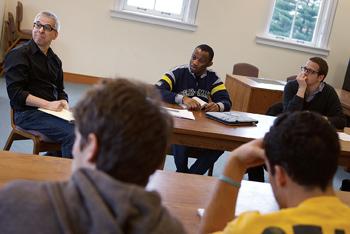By William Sweet
 Parker (left) teaching his “Big Books” seminar
|
In a literature class, works might be surveyed by country, or time period, or language. This past fall, English Professor Andrew Parker’s students studied literature by the pound. At the beginning of every semester of “Big Books,” the first-year seminar that Parker teaches, he makes a show of coming in carrying the three tomes that students will tackle. He puts them each on the desk. Thud. Thud. Thud.
“It makes a big sound,” he says, “and [students] go ‘Oh my God, what am I in for?’” What they are in for is a challenge and, Parker hopes, a joy. “Big Books” allows students to examine great works of literature in depth and at a relatively leisurely pace. Each semester, Parker picks a different trio of books that have only their girth in common.
“It’s a peculiar thing in literary study,” Parker says. “There’s no good account of the way that length factors into the structure of a book. There’s plot, there’s a narrator and there are characters, and you can plot the moment of climax and resolution, but these are all factors of narrative and not the long novel. My question is: Do long novels have issues that distinguish them from short works?”
Last semester, students made their way through Moby-Dick, by Herman Melville; The Man Who Loved Children, by Christina Stead; and Dhalgren, by Samuel R. Delany. These novels tally up to about 2,000 pages, giving students an average of about 100 pages of reading homework for each time the class meets.
Taken in these smaller chunks, the workload seems less intimidating. Indeed, it’s roughly the same amount of reading that each student might do for another course, but “Big Books” doesn’t divide students’ attention among numerous books and essays. Each student writes a paper every week, focusing only on what the class has just read. “It’s very exciting to write all those papers,” says Melih Levi ’15. “It’s like a book club.”
Students can come out better readers, better students and with a shared experience, Parker says. “They really do bond. I have had people who have met in this class, and they have stayed very close friends. I’ve been to their weddings.”
While he changes books each semester, Dhalgren is a perennial favorite. Published in 1975, the 880-page science fiction novel follows a drifter and apparent amnesiac as he travels through a city that’s become isolated by a mysterious phenomenon cutting off all transmitted communication. The book lacks a linear plot and is marked with schizoid babble, sex and stream-of-consciousness narrative. “Its kind of narrative challenge,” Parker says, “is unlike anything [students] have experienced before or ever will again.”
Usually the course starts with “a good British 19th-century page-turner,” such as a novel by Dickens or Eliot, and then moves to something more contemporary or that pushes the boundaries even further—or both, as in the case of Dhalgren. “What’s important,” Parker says, “is that the novels be sufficiently dissimilar.”
Bridging last semester’s spot between whale-hunting and apocalypse is The Man Who Loved Children, published in 1940 but largely unnoticed until a reissue in 1965. Time magazine described it as “the greatest picture ever of the lousiest family of all time.” It’s the semiautobiographical story of a blended family beset by self-absorbed parents who have toxic relationships with their six offspring. “It’s domesticity portrayed in a way that had never been portrayed before,” says Parker. He had long put off reading the novel, “until I realized that someday I would never get ’round to it.”
When he finally picked it up, “boy, was I glad,” he says. In fact, Parker recently met with some alumni with Hollywood connections, in hopes of sparking their interest in a film based on the novel, but “people said, ‘I’ll have to read the novel first, before I adapt it.’”
So it may be a while.
Photo by Rob Mattson